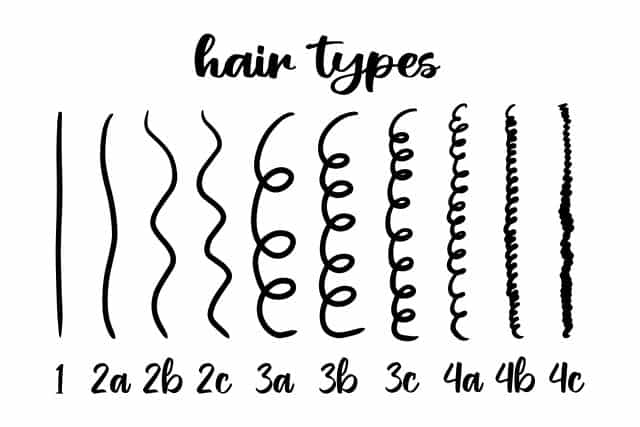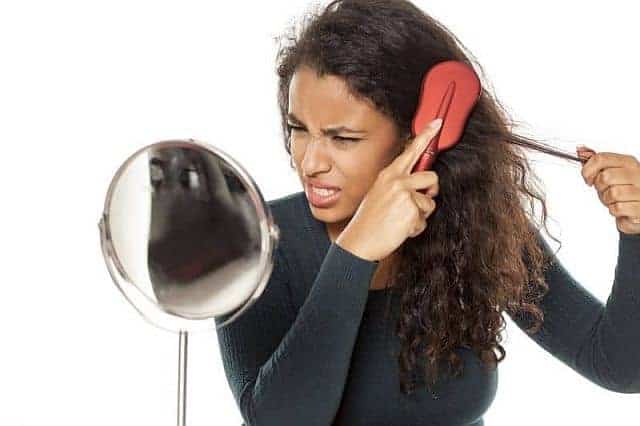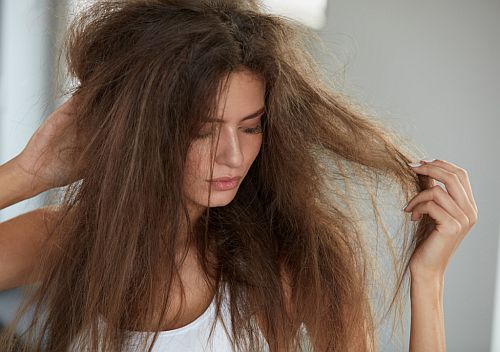Last Updated on January 1, 2023 by Gaga
Tangled hair can be frustrating, especially if you have naturally wavy or curly hair. Long, dry, and fine hair can also get tangled easily. High-porosity hair has a rough surface, so you are more likely to have matted hair if your hair is overly porous due to regular coloring and other chemical treatments. Dry porous strands rub against each other and become intertwined, forming tangles in your hair.
Simply put, detangling is the process of working tangles or knots out of your hair. Untangling matted hair can be a painful and time-consuming task. However, you must resist the urge to use too much pressure or rush through the process as this can lead to breakage, split ends, and damaged hair. When done properly, untangling makes styling easier, reduces the possibility of breakage, and helps to retain hair’s length.

The ideal frequency of hair detangling varies on hair type and texture. A good practice is to untangle your hair on washing days to get rid of shed hair caught within other hairs and also release tangles.
What’s the Best Way to Detangle Your Hair?
First, let me say that there is a good way to detangle your hair and a bad way to detangle your hair. What makes the difference is how much damage or breakage you cause as a result of doing it. If you’re being rough with your hair, and you’re ripping the brush through your hair, then then you’re causing a lot of damage to your hair, especially the ends. This will cause your hair to break off and will make your hair even more prone to tangling.
Finger combing or finger detangling is, by far, the best method since it causes the least breakage and makes it nearly impossible to be rough with your hair. Its biggest downside is it takes the most time to do, but if you’re willing to put in the time, I promise you it’ll be worth it.

Here’s how to finger-comb your hair:
Start with wet hair with some conditioner in it. Take out a small section of hair and work from the ends, slowly trying to run your fingers through the length of your hair. When they snag, stop and try to pull apart the individual strands that have combined to form the knot. Try to loosen the hair around the knot and unravel it gently. To avoid putting too much stress on your scalp, hold a section of the hair with one hand while finger-combing your hair with the other hand. Once that section is detangled, twist, braid or pin it away.

Another really helpful way to work tangles out of your hair is to grab right under the tangle with one hand, making sure that you hold your hair taut. Then, use your other hand to split the hair above the tangle into two sections and use your fingers to push the sections in opposite directions. As you feel the tangle start to loosen, move the hand that was gripping the hair further away from the tangle, and hold your hair taut. Use your other hand to keep pushing the sections above the tangle apart.
Detangling Hair Care Products
Make sure to use the best detangling tools and products to manage knots without pulling or breaking off your hair.
Detangling Shampoo and Conditioner
Harsh, sulfate-based shampoos can cause dryness and increase porosity, resulting in tangle-prone hair. So, avoid sulfate-containing shampoo and use a mild, moisturizing shampoo to increase moisture retention and keep your hair feeling soft and silky.
Gently massage the scalp with the pads of your fingers and let the lather run down your hair. Try not to scrub your hair while washing it to prevent post-shower knots.
After rinsing out the shampoo, saturate your hair with conditioner and leave it on for a few minutes. The conditioner will decrease friction between hair strands and make your hair more slippery and easier to comb. Use a conditioner that has lots of slip for easier detangling and to provide silkiness and manageability. Consider products that are specifically designed to untangle knotted hair.
Detangling Leave-in Conditioners
Leave-in detanglers are formulated to moisturize and smooth your strands, unravel the knots, and prevent breakage.
When you apply a leave-in conditioner to towel-dried hair, comb through it again, to ensure that all the knots are out. If you meet resistance, gently work the tangle out. On days that you don’t wash your hair, apply a leave-in detangler before styling to give your hair more manageability. Select a product that will not coat your strands with chemicals or leave your hair feeling greasy. For your convenience choose a detangler that can be used on both wet and dry hair.
Quality leave-in detanglers you should consider include Kinky-Curly Knot Today Leave-in Conditioner/Detangler, ENJOY Conditioning Spray, ORIBE Priming Lotion Leave-In Conditioning Detangler, Revlon Uniq One All in One Hair Treatment, and Cantu Care for Kids Conditioning Detangler.
Detangling Tools
Even though finger detangling is the preferred method, understandably, you may still want to use combs and brushes to detangle.
2. Wide-tooth combs. Fine-tooth combs, such as rat-tail combs should never be used for detangling. Opt for wide-tooth combs that are a lot gentler on wavy, curly, and coiled hair types. A sandalwood comb is another great tool to make the detangling process easier. It smells pleasant with a hint of sandalwood, so rest assured; it is 100% natural without any synthetic ingredients that could lead to underlying harm. The comb smoothly glides through the hair and tackles tangles, knots, and messes efficiently, reducing hair breakage.
2. Detangling brushes. These are brushes specially designed for women with curly hair to make detangling easier, faster, less damaging, and a lot less painful. Everybody and their mother has heard of the Tangle Teezer, EZ Detangling Brush, or Felicia Leatherwood Brush, and there’s a good reason for that: these brushes do work!

Tangle Teezer The Original Detangling Brush is ideal for hair that gets knotted easily. It is suitable for all hair types and can be used either on wet or dry hair. It is conveniently sized to fit comfortably in your hand. Two-tiered bendable teeth allow the brush to glide through your hair and make it knot-free with minimal damage. The longer bristles gently remove tangles and knots while shorter bristles smooth the hair cuticle to provide extra shine.
How to Prevent Tangled Hair
- Try pre-shampoo treatments. If your hair is prone to knots and tangles, consider including a pre-poo treatment in your hair care regimen. An oil-based pre-shampoo treatment will create slip that helps reduce friction, minimize tangles, and lessen hair breakage.
- Use conditioner regularly. Use conditioner after every shampoo to smooth the cuticle layer of your hair. Properly conditioned hair is silky and pliable and is less likely to get knotted.
- Do deep conditioning. Deep condition your hair at least once a week to help restore natural moisture and oils and keep your hair smooth and easy to style.
- Consider changing your sleeping habits. Sleeping with your hair down causes it to easily get tangled, especially if you have long hair. To prevent hair strands from knotting while you sleep, loosely braid your hair or tie it up in a ponytail before you go to bed. Also, opt for a silk or satin pillowcase to lessen friction between your hair and the pillow to minimize knots and tangles.
- Protect your hair from windy weather. Cover your hair with a satin scarf or a hat on windy days to reduce exposure to wind and prevent your tresses from getting messed up. Braids are a good option during windy weather. You can let your hair down when you arrive at your destination.
- Trim your hair regularly. The roughness of dry and split ends contributes to knotty hair. Keep your strands healthy by trimming off split ends every 2-3 months.
- Use only quality hair accessories. Wear your hair up using only safe, non-damaging hair accessories. Avoid using uncovered elastic bands, and hair accessories with sharp edges, as they can cause damage, making your hair more prone to matting and knots.

Gaga is a blogger and founder of the Softer Hair website. She often says that insomnia is to blame for her first blogging attempts. Being the night owl, she hated the morning alarm. She left her office job and returned to what she loved most - writing.


My hair is so long . I think, I need to cut everything off cause I’m so tired of always brushing the knots out. I get normal trims, I solid have part closes, I never utilize heat on it, I profound condition it once every week. What am I doing wrong??
Thank You for these tips on untangling my hair. I don’t know what happened but it is so knotted up. I’m doing the oil /fingertip/conditioner thing as I read this over. I’m scared it won’t untangle.
Your tip is very helpful. My hair is so long I want to cut my hair some. I shampoo once a week. Is it right for me?
Thank u so much this method is really very helpful to my wife.
Actually, this is a big problem. When going to shower you need to bring your preferable shampoo then use this in the right way before completing your bath. I think your problem will be solved.
You see people don’t really take tangled matted hair serious until it happens to their hair. Truly distressing, frustrating and depressing.
Always seek professional HELP -it’s crucial. There are salons Tangled hair techs that can detangle and use the Take-Down remover product to detangle.
The key is just don’t give up and cut your hair. check out hairdetanglerschool.com for how-to videos as well.